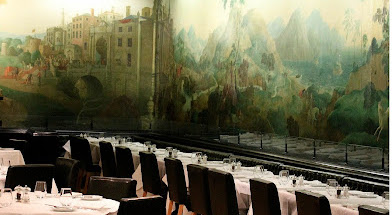
In 1956, over sixty years before the Tate Gallery ethics committee decided to close it over criticisms of its ‘racist’ mural, Fanny and Johnny Cradock paid a visit to the famous Rex Whistler Room restaurant in the Tate Gallery. They were there to sample the menu brought in by its new owner, a Mrs Adams, to replace ‘railway sandwiches, canteen tea and dish-water soups ‘. In place of these the visitors found:
‘ palatable soups (9d), respectably-fried fillets of Dover Sole and properly-cooked chips (3s 9d) , adding for good measure grilled trout and turbot for 4s 6d, chicken, ham and mushroom vol-au-vent garni for 6s, and a nice homely plate of braised beef and vegetables for 4s 9d. Fresh fruit salad with ice-cream and cream costs only 1s 9d. Chef makes a tour of the restaurant daily to ensure all is well with his clients.’
Rather bizarrely, no mention is made by Fanny and Johnny of the astonishing mural, ‘ ‘An Expedition in Pursuit of Rare Meats ‘ by the twenty-one year old wunderkind of British decorative art, Rex Whistler, which by now had been there for thirty years, possibly because the couple were there to discuss food, and anyway most cultivated diners-out in the metropolis would already have been aware of the art work. Fast-forward to 2020, when the restaurant was last open to the public. The mural was still there, but in place of fish and chips diners with large pockets could expect to find very fine dining indeed and a reputable wine cellar commensurate with a gallery containing the greatest of British art.
But all was to change following an online post by an activist group calling itself ‘ White Pube’. This called attention to the imagery employed by Whistler, which included stereotypes of Chinese people and, worst of all, the figure of an enslaved black child being kidnapped by traders, hauled along by a rope in front of its distressed mother. According to the post, the notion of dining in the presence of imagery that represented the worst examples of the racism inherent in colonial power was an affront to present day values of equality and diversity. The online response elicited by this attack strongly suggested to the Tate trustees that the issue required immediate action and so a committee containing the great and the good was formed to debate the issue.
Despite the fact that these ‘offensive ‘ images had been around for over ninety years, without action being called for, it was generally agreed that in the present climate something must be done to address the problem. But what? A mural, however controversial, could not, unlike a painting on canvas or paper, be removed and placed in storage. Nor, as an art work owned by the nation, could it be painted over, despite the fact that so many murals in the past in other locations, had been destroyed this way. Presumably the idea of covering up the mural with blank panels that would not excite curiosity must have been discussed but rejected as wholly inappropriate. What everyone agreed on was that the restaurant needed to be closed—not just because of the mural but also due to Covid restrictions. This was rather convenient, as it gave the committee more time to consider permanent solutions to the problem.
Meanwhile, the whole debate created a media storm. Most responses fell into two distinct camps, largely, but not wholly, depending on their political stance. Many agreed with the criticism raised by White Pube, but the most logical arguments came from the travel writer Hugh Thompson in the Spectator who contended that the accusations of racism levelled at Whistler were ill-founded .There was no evidence to suggest that by showing instances of racist practices the artist condoned this conduct, just as there is no evidence that by showing in his ‘ Disasters of War’ series the butchering of enemy soldiers and civilians Goya supported mass slaughter. Quite obviously the artist was a satirist who wished to expose the barbarity of military commanders. Could it be that Whistler was a critic of colonialism and that the imagery he included in his mural was meant to expose bad practice? We’ll never know. The artist died young and left behind no commentary on his art.
The general consensus was that the mural reflected the values of another age and therefore far from protecting the public through censorship, it should remain in situ and that some sort of interpretation of it from a contemporary artist ought to be initiated. Autres temps, autres moeurs.
As for Mrs Adams and her vol au vent garni that Fanny and Johnnie considered such an improvement on ‘ railway sandwiches ‘ , there is little or nothing on her online, which is a pity. Her new menu was a step in the right direction. After all, this was the Whistler Room in the Tate– one of the most famous art galleries in the world.
R.M.Healey.
